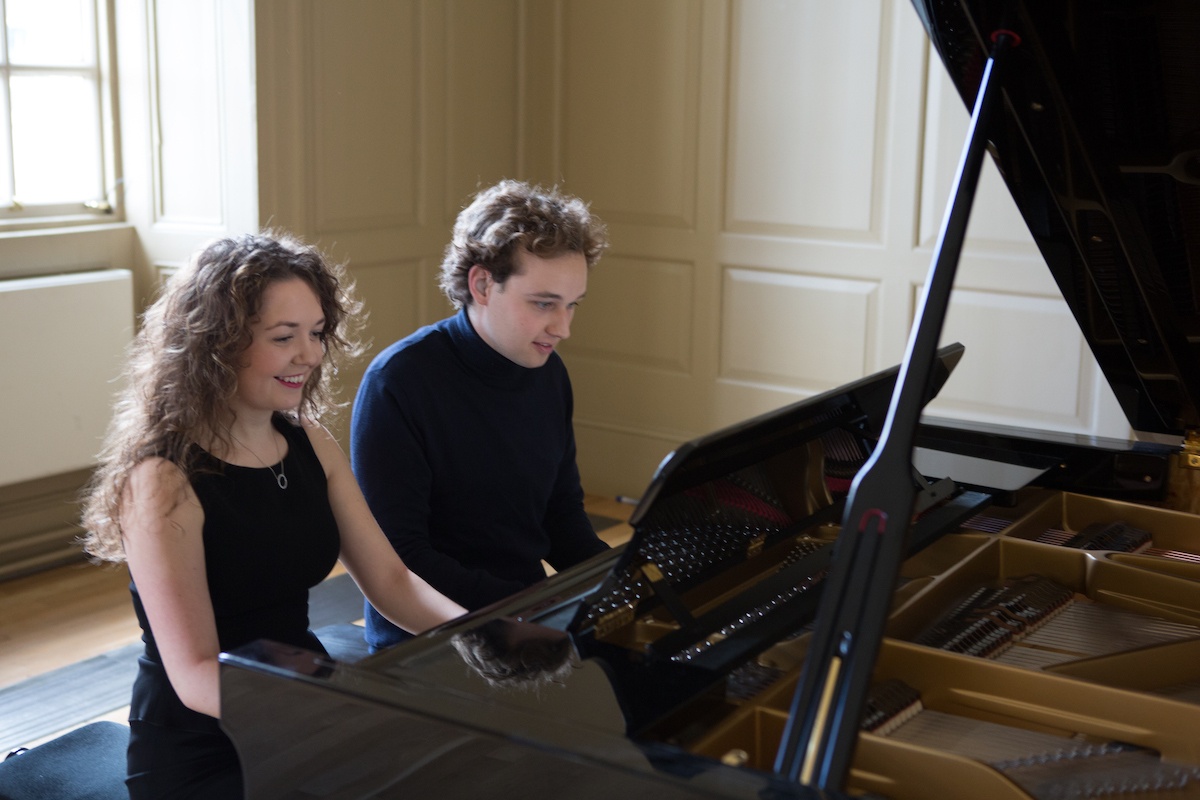
Incorporating improvisation into your piano lesson

BY: Guy Bunce
23 January 2018
Picture these scenes: a new piano student arrives and says ‘I really want to learn to improvise’, or an existing student says ‘I’ve downloaded this lead sheet that only gives the melody and chord symbols. My school teacher wants me to play it in assembly’. For many piano teachers schooled in the classical tradition, such requests would make the blood run cold. For the children they teach, however, improvisation and composition has been at the heart of classroom music for decades. Guest author, Guy Bunce, sheds a light on the topic presenting his take (out of many) on how to approach teaching improvisation.
As a practitioner of both classroom teaching and piano teaching, I have witnessed a gulf between the notation-based approach of individual piano lessons and the creative, minimal-notation approach of classroom music. Whilst each has its merits, marrying aspects of both approaches can, in my view, lead to the development of a more rounded musician and greater enjoyment.
Improvisation as a tool for musical growth
I should open by stating that I place myself firmly in the category of ‘classically schooled musician’ but was lucky that my musical journey took me through many years of playing by ear before I underwent formal classical training.
I think it is this aural background that formed my view that improvisation is a key component to musical understanding, teaching musicality, and by extension a worthy tool to be employed in piano lessons. I was delighted to see that Trinity has included improvisation as an option in their graded music exams. This creative and pedagogical tool will appeal to many students and I hope that this blog post will help to demystify the practice for teachers, showing how improvisation is an excellent tool for supporting piano students’ musical growth.
Throughout my piano teaching career, I have included improvisation in my lesson plans on the basis that it is rewarding for students of all styles of music. To name but a few, it can:
- Help a student become familiar with their instrument.
- Give students a sense of ownership.
- Help students assimilate complex musical ideas.
- Teach phrasing and structure which, in turn, informs performance.
- Create a way forward for students struggling with motivational lulls.
- Support students to access the classical tradition through music of their vernacular (often in the form of popular styles).
Below are a number of improvisation exercises I use with my piano students to support their general piano playing and teach some more complex musical skills.
The Pentatonic Vamp
Exercise: The teacher plays a simple ‘oom-pah’ style chord sequence in common time with one chord per bar. The chord sequence is I-II-V-I in F# major and can be repeated as many times as necessary.
The student is encouraged to improvise a melody over the top using just the black notes.
Tips: I initially tend to give my students no other guidance than 'try making a tune over my chord.' From a classroom music perspective this would be called a ‘cold task’ in which the student’s area of improvement is as important as their success.
For example, the student may react by using two hands and produce clusters or chords. This can lead to an interesting dialogue of why this doesn’t work melodically and how melodies are usually one note at a time.
The student may react by playing with huge leaps between notes, which can inform a discussion about conjunct motion in melodic writing. Their rhythm might be very pedestrian to start with and this can generate conversation about rhythmic interest and even how their ideas might be notated or developed.
The teacher can vary the style of accompaniment (flowing arpeggios) and discuss with the student how their response may change.
Supporting Piano Pedagogy:
- This exercise is great for teaching phrase structure by giving the student first-hand experience of what a phrase feels like. I have noticed that students soon get the hang of feeling the end of the phrase and will often include a long note at the end. Phrase recognition is a constituent part of theory exams and advanced aural tests. It can also lead on to talking about cadences.
- The shape and contour of the student’s melodic line can be analysed to help inform their general playing and how dynamics and articulation can be informed by contour and phrase. This is particularly useful when a student is working on a baroque piece without any written dynamics.
- By varying the teacher’s accompaniment style, the student is likely to respond differently. For example, the oom-pah accompaniment may spur the student to produce a bouncy staccato piece in the style of cartoon music. A flowing accompaniment may produce a more legato line. Such changes can inform a discussion about styles, which can be related directly to the exam repertoire and help students adopt a suitable style of playing.
- The many musical elements at work in this exercise (pitch, contour, rhythm, articulation, dynamics) can help support preparation for aural tests.
- More advanced students might like to take on the accompanist role and this can be useful as a method of teaching appropriate chord voicing.
- If the exercise is transposed into C major, fingering patterns can be more readily explored and discussed.
Chord Voicing Exercise:
Exercise: The student is given a simple chord pattern (I-IV-V-I, or I-V-VI-III-IV-II-V-I) and taught how chords are built from the scales. They should first play the chord pattern in the right hand in root position and note how the hand has to jump around.
The student is then taught about inversions and to look for common tones between chords that they can keep in the same finger, therefore creating a smoother movement through the sequence. The left hand can be added to provide the root of the chord and simple styles of piano accompaniment taught whilst the teacher improvises over the top. Trinity’s improvisation videos with Lucinda Mackworth-Young illustrate this approach in great detail.
Tips: If the exercise is being completed in C major, the motion between the first two chords of the sequence (I-IV) would have ‘C’ as the common tone and therefore a smooth movement from a root position ‘C’ chord might move to a second inversion F.
Students could be given the task of coming up with their own 4 or 8-bar chord sequence for homework.
Supporting Piano Pedagogy:
- This exercise is very useful for developing students’ instinct for chord fingering.
- It can help students build up their knowledge of chords and the ability to recognise different chords by name.
- An awareness of chord names is useful for memorising music and condensing information. For example, when sight-reading, if a student sees a written chord as three notes, they have three pieces of information to process. Whereas if they see it as an E-minor chord they have one piece of information to process and knowledge of possible fingering.
- Examining chords in this way is particularly useful when the student has written their own sequence and can lead to discussion of cadences and harmonic direction. Both topics obviously come up in theory exams but, more importantly, knowledge of harmony can help foster expressive development. A piano student of mine who had undergone similar exercises was able to use them to inform her interpretation of Debussy. She was able to see clearly when Debussy was circumventing the key and therefore apply suitable rubato to mark these moments of surprise.
- Knowledge of chords can help support a student struggling with scales and remembering their key signatures.
- This exercise can be extended to look at lead sheets where only the chord symbol and melody are given. Pieces such as ‘When The Saints Go Marching In’ are readily available online. The ability to realise a lead sheet is very useful for any student wishing to work in musical theatre, pop, or accompanying.
Reacting to a Stimulus
Exercise: The student is given an evocative title (‘Night in a Forest’, ‘Windswept Hills’, ‘Sunrise’, or ‘A Haunted House’) and encouraged to respond to it musically.
Tips: This open-task can appear very daunting but has many musical benefits. A student may pick very dissonant sounds for the haunted house. They may pick running passagework for windswept hills.
The discussion between teacher and student about the results is equally as important as the task itself.
Supporting Piano Pedagogy:
- Nearly all of the aforementioned benefits come into play in this exercise, depending on how the student interprets it: fingering, harmony, scale, dynamics, articulation, interpretation etc.
12-Bar Blues
Exercise: While the teacher plays a 12-bar blues accompaniment in C Major, the student improvises using the blues scale in C.
Tips: This is really an extension of the ‘Pentatonic Vamp’. I use this exercise with my piano students and also my school classes. I am always surprised by how musically some of my Year 4 students respond! The exercises appear to bring out otherwise untapped musical understanding.
Supporting Piano Pedagogy:
- Aside from the benefits noted in the other exercises, this task is very useful for teaching fingering and thumb-passing technique, particularly when the scale is extended to two octaves. By requiring the student to use their right hand thumb on C, F, and G it can support thumb movement in more conventional scales.
- Responses can lead to discussions about various musical elements that, in turn, help build a musical ear to support performance and aural-tests training.
- This exercise can be a great motivational tool for jaded students.
- Explore this approach further in Trinity’s improvisation videos with Lucinda Mackworth-Young.
Developing the whole musician
These are just a few of the exercises I use with my students. What is important to say is that improvisation does not have to be regarded as an end in itself, but as a means to tap the creative potential of your students. Use it to help teach complex musical concepts and support their general playing.
All of my students use improvisation to assimilate skills and consolidate both their technique and musical understanding. My mantra is to strive to develop the whole musician. As their musical appreciation grows, this will inform all of their musical endeavours.
 Guy Bunce graduated in 2001 from Kingston University where he specialized in composition and won the Kingston Composition Prize for Dulce et Decorum Estwritten for Baritone and Orchestra and based on Wilfred Owen’s poem. He went on to achieve a Masters degree in composition at Royal Holloway University of London, studying under Philip Cashian, Tansy Davies, Brian Lock, and John Woolrich.
Guy Bunce graduated in 2001 from Kingston University where he specialized in composition and won the Kingston Composition Prize for Dulce et Decorum Estwritten for Baritone and Orchestra and based on Wilfred Owen’s poem. He went on to achieve a Masters degree in composition at Royal Holloway University of London, studying under Philip Cashian, Tansy Davies, Brian Lock, and John Woolrich.



.png)


Comments & Replies